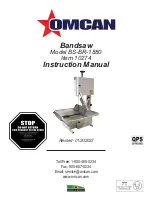
tool, any part that appears damaged should
be carefully checked to determine that it will
operate properly and perform its intended
function.
• Check for alignment and binding of all
moving parts, broken parts or mounting
fixtures and any other condition that may
affect proper operation. Any part that is
damaged should be properly repaired or
replaced by a qualified technician.
• Do not use the tool if any switch does not
turn off and on properly.
• Never force the tool or attachment to do the
work of a larger industrial tool. It is designed
to do the job better and more at the rate for
which it was intended.
• Always unplug the cord by the plug. Never
yank the cord out of the wall.
• Always turn off the machine before
unplugging.
• With normal use, the motor housing may get
hot.
• Make all adjustments to the machine with the
power OFF.
• Never leave the cutting off wheel saw
unattended while it is running.
• When turning off the machine, never leave
the cutting off wheel saw until it has come to
a complete stop.
• Make every effort to prevent snagging
by exercising special care when working
corners, sharp edges, ragged welds, etc.
• Do not use a cutting off wheel that is not in
accordance with specified sizes.
• Never carry the tool by the cord.
• Don’t pour water or coolant on cutting off
wheel when cutting.
• Make sure to secure cutting material so it
does not move during operation.
• Cutting material can get extremely hot during
operation.
If there is any question about a condition
about a condition being safe or unsafe, do
not operate the tool.
Operating instructions
■
CUTTING PROCESS, FIG. 2
Insert the work-piece and fasten it with clam-
ping handle 5 (fig. 2).
Pay attention that the cut-off wheel does not
touch the work-piece when turning the machi-
ne on.
Switch the machine on; wait until the cut-
off wheel has reached full speed. Move the
machine head carefully downwards to the
work-piece.
Ensure you have constant pressure while
performing cut-off grinding work.
After the cutting switch the machine off and
move the machine head up.
Caution! The work-piece can get extremely
hot!
■
DIAGONAL CUTS: FIG. 3
For diagonal cuts, loosen both hexagon bolts
A of the rear clamping jaw, adjust the angle,
and tighten both screws again.
The clamping claw B automatically adjusts
to the angle. To do this, please use the ring
spanner (17mm).
■
QUICK CLAMPING LEVER: FIG. 4
The machine is equipped with a quick
clamping lever 8.
Move the lever 8 up, push the clamping
handle 5 forward to the work-piece, push
lever 8 down, afterwards lock the work-piece
using the clamping handle 5.
Attention! Prior to the cutting process, always
check that the work-piece is correctly and
securely tightened.
Long work-pieces must be supported by a
dolly (rolling support) or similar.
After work completion, place the machine
head in the lower position and pull out the
mains plug.
■
CUT-OFF WHEELS – REPLACEMENT FIG. 5 - 6
Attention! Pull out the mains plug.
Move machine head up, unfasten butterfly nut
C, move the cover plate B and flexible guard
10 up until the clamping screw of the cut-off
wheel is freely accessible. Press locking bolt
9 (fig.6)
Move cut-off wheel by hand until the locking
bolt locks in place. Unscrew the clamping
screw by turning it counter-clockwise, using
the enclosed allen key. Remove the clamping
flange and the screw, mount the new wheel
and clamping flange, pay attention to correct
and neat position of the cut-off wheel, tighten
the screw slightly by hand, press the locking
bolt and fasten with the cut-off wheel spanner.
Mount the protective equipment and secure it
with butterfly wing.
Check the functioning of the protective
equipment.
Attention! Cut-off wheel bore diameter must
match the flange diameter.
■
TRANSPORT: FIG. 7
Caution! Unplug
Press to move the machine the machine head
down and lock it with the locking bolt (12).
The saw is then locked in the bottom position.
■
OVERLOAD PROTECTION FIG. 7
The engine of this equipment is protected by a
circuit breaker (3) against overload.
When the rated current is exceeded, the
overload switch (3) on the device. After a short
cooling interval, the device can be switched on
again by pressing the overload switch (3).
Electrical connection
m
The electrical motor installed is connected
and ready for operation. The connection
complies with the applicable VDE and DIN
provisions.
The customer‘s mains connection as well
as the extension cable used must also
comply with these regulations.
•
The product meets the requirements of
GB
14










































